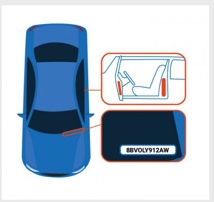In recent years, recalls directly related to CPS have been more common among vehicles than CRs. And, since all recalls are safety-related, any vehicle recall (including the vastly greater number that are not specifically about CPS) can indirectly harm child passengers. So, the fact that NHTSA says over 50 million vehicles on the road have one or more open recalls is a serious safety concern.
For the past couple of years, the National Digital Car Seat Check Form (NDCF) has included the recommendation to check for vehicle recalls. But, unlike CR recalls, CPS-related vehicle recalls aren’t compiled in one handy list. Rather, all open recalls on any given vehicle must be scanned to find CPS-related recalls.
While pulling up and scanning through a vehicle’s open recalls during a checkup is ideal, doing so isn’t always possible. However, advising vehicle owners to check for recalls on their own—and pointing them to available online lookup tools—is a good habit for CPSTs to adopt.
Look up vehicle recalls using two tools
The public has two options for looking up vehicle recalls; both require the use of a connected digital device, like a computer, tablet, or smartphone:

- NHTSA: Find open recalls by entering a vehicle’s 17-digit vehicle identification number (VIN). This site also offers the ability to see all recalls for a given vehicle model by selecting Vehicle and entering a year, make, and model.
- National Safety Council, Check to Protect: Enter the VIN or a vehicle’s license plate number to find open recalls. This site also allows users to look up recalls by taking a photo of the vehicle’s license plate using a smartphone or tablet.
Tech Tip: Use Vehicle Recall Tools to Get Model Details
A tip for CPSTs is to use recall lookup tools to gather a vehicle’s name and other information. Along with any recalls, the tools list the vehicle’s year, make, and model, which can be helpful for filling in checkup forms, like the National Digital Car Seat Check Form (NDCF).
For this purpose, Check to Protect seems to provide more detail. If a tech needs the model year of, say, a Volvo V60, either tool will provide that information. However, while the NHTSA tool lists the year/make/model (i.e., 2016 Volvo V60), Check to Protect includes trim information (i.e., 2016 Volvo V60 T5 Drive-E Platinum). SRN input a VIN using the NHTSA tool and found it was for a 2022 Ford F-250, while the same VIN was described as a 2022 Ford F-250 Super Duty XLT in Check to Protect. This added detail can be useful, particularly when looking up information in the LATCH Manual or entering data into the NDCF that’s more meaningful for vehicle manufacturers.
Which recall tool is better?
Either vehicle tool works well and has pros and cons. Both list and detail only open recalls for specific vehicles, so recalls that have already been fixed won’t appear and cause confusion. But there are reasons to use one over the other, depending on the situation.
For instance, being able to enter a license plate number, rather than the much longer and harder-to-see VIN, may make Check to Protect easier to use to look up recalls during checkups. Check to Protect’s option of simply taking a photo of the license plate using a smartphone camera makes looking up vehicle recalls easier still.
Another advantage to Check to Protect is that it gives organizations with fleets of many vehicles a way to conduct bulk recall checks. Select Fleets/Dealers from the home page to learn more about this service. CPSTs who work with fleet owners, like pupil transporters or paratransit operators, can pass along the tip to set up an account on this site so the owner can more easily learn if there are open recalls on multiple vehicles.
Check to Protect, however, gets its information through the company Carfax, and a small number of brands don’t share information with the company. Most are motorcycle or commercial truck makers, but there are a handful of passenger vehicle makers that don’t work with Carfax (Lucid, Rivian, and Tesla). Only the NHTSA site includes recall information on these three car brands that make electric vehicles.
The NHTSA site also offers CR recalls, so it has the advantage of offering one site for looking up both products during a checkup. NHTSA’s Safercar app allows a user to enter one or more car models (or CRs or tires) in order to receive an alert when/if a recall is issued on that product.
The time to act on vehicle recalls is now
The bottom line is that either lookup tool works—what’s important is that caregivers check for open recalls, one way or another.
And they’ll want to do that as soon as possible, because while vehicles don’t ever expire, vehicle recalls do! From the date of announcement, the vehicle manufacturer is required to provide owners with a free recall fix, but federal law mandates this obligation for only 15 years. After that, the owner would have to pay for the fix, and there is no guarantee that the fix kit would still be available.
Fifteen years may seem like a long time, but it is not nearly as long as some families hope (or need) to use their vehicles. So, when urging caregivers to look up and act on open recalls, a ticking clock is another reason to relay a sense of urgency.
